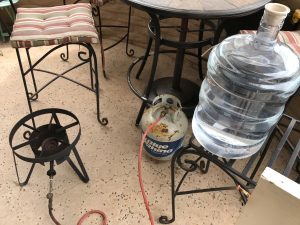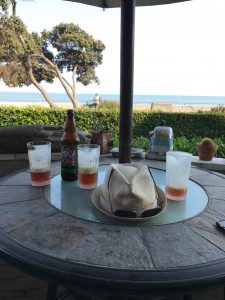It all began when Enrique Lopez was given a beer making kit from his now X girlfriend. Not having a clue about home brewing, yet curious, I attended the brew day session to take some notes and to witness the process. Looking back now, we really did not have any idea what we were doing. We simply followed the recipe that came with the kit, which also provided the brewing material for a 5 gallon batch.

First brew day setup
The recipe used extract for the wort. That is the best way to start your first batch, taking out the extra steps of milling grain and soaking them into wort at a set strike temperature. Who needs to think of those things when you can simply use extract?
Here is how the beer was made, step-by-step…
| Step | Description |
| 1 | Started to boil 2.5 gallons in 5 gallon kettle |
| 2 | Stirred in extract as water warmed (9.5 lbs) |
| 3 | Added in additional 6 lbs of extract after water came to boil |
| 4 | Additional water added for 5 gallons total. |
| 5 | Kept mix at boil for 60 minutes, stiring occasionally to keep bottom of kettle from burning extract. |
| 6 | Note: Two boil-overs (over top of kettle) occurred during boil. Ooops |
| 7 | Put kit hops in socks and added per recipe during boil. |
| 8 | Placed 5 gallon kettle in kitchen sink with ice to cool to 70F |
| 9 | Transferred wort to fermentation bucket after cooling |
| 10 | Pitched dry yeast that came with kit, put lid and airlock on bucket. |
| 11 | Two weeks later, transferred liquid from fermented to 5 gallon bottling container |
| 12 | Boiled priming sugar, cooled, and added to transferred liquid. |
| 13 | Bottled and capped brew in sanitized 22 oz bottles |
It was at least 3 weeks before we chilled and cracked the first bottle.

Sampling 1st bottle
Disappointing, it was what I know is referred to a “green”. That is, beer wort that underwent insufficient fermentation. If you know what green beer taste like, well, it is not the result you are looking for. Yuck!
We thought that perhaps it was not sufficiently conditioned, so we waited another 3 weeks. Still green!
And even after months of conditioning, the taste did not improve.
Looking back, and after researching on line we now know the fermentation failed as result of using dry yeast. That mistake will never be repeated. The lesson from this first brew is to use fresh, liquid yeast to ensure optimal fermentation.